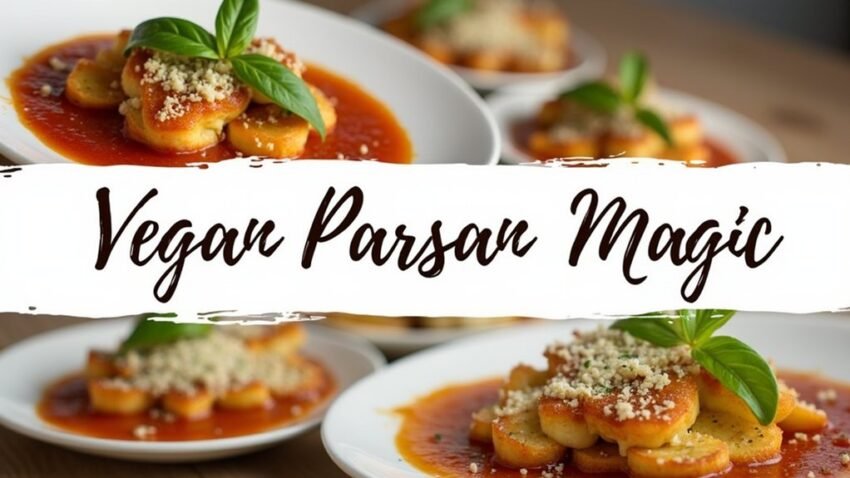Vegan Parmesan Magic

Vegan Parmesan Magic
Vegan Parmesan might seem like a contradiction, blending the rich, savory essence of traditional cheese with the virtues of a plant-based diet. You might wonder how this delightful ingredient can enhance your meals while adhering to a sustainable lifestyle. As you investigate its origins and versatility, you’ll uncover tips to create a version that not only complements your favorite dishes but also aligns with your health goals. Curious about how this simple ingredient can transform your culinary approach?
Key Takeaways
- Vegan parmesan brings a rich, cheese-like flavor to dishes while being completely plant-based and healthy.
- The recipe includes affordable and accessible ingredients like cashews, Brazil nuts, almonds, and nutritional yeast.
- Customizing vegan parmesan allows for unique flavors with herbs, spices, and alternative ingredients for specific dietary needs.
- This versatile topping enhances various meals like pasta, salads, and pizzas, making plant-based eating exciting and delicious.
- Incorporating vegan parmesan supports sustainable eating practices and reduces environmental impact while promoting a healthy lifestyle.
History
From its ancient origins in East Asia to the modern kitchens of today, the history of vegan cheese, particularly vegan Parmesan, reveals a fascinating culinary evolution.
-
16th Century: The journey begins with fermented tofu in China and the Okinawa Islands. These early versions resembled cheese in texture and were used as a condiment.
-
1970s-1980s: Initial commercial vegan cheese products emerged, but many had waxy or chalky flavors and textures.
-
Ingredient Evolution: Over time, manufacturers began incorporating a variety of ingredients, such as seeds, plant-based milk, and nuts, to improve both taste and texture.
When it comes to vegan Parmesan, this innovation took it a step further.
-
Key Ingredients: Commonly made with cashews, nutritional yeast, and savory spices, vegan Parmesan aims to replicate the cheesy, nutty flavors of its dairy counterpart.
-
Quality Shift: The 1990s and 2000s marked a significant improvement in vegan cheese quality and variety, solidifying its place in plant-based diets. The introduction of nutritional yeast as a key ingredient significantly enhances the flavor profile of vegan Parmesan.
As you investigate vegan Parmesan, you’ll uncover a reflection of changing culinary practices and a response to evolving dietary preferences.
Recipe
Vegan Parmesan Magic: Recipe
Creating a delicious homemade vegan parmesan is easier than you might think, and it’s a fantastic way to boost your meals while keeping them plant-based and healthy. This recipe uses raw nuts and nutritional yeast to create a rich, cheesy flavor that’s perfect for sprinkling over pasta, salads, or pizzas. Plus, making it at home not only saves you money but also gives you full control over the ingredients, making sure that you avoid any additives or preservatives commonly found in store-bought versions. The recipe yields approximately 1 cup of vegan parmesan, making it a perfect long-lasting topping for various dishes.
To get started, gather all your ingredients and tools. A high-powered blender or food processor will be your best friend in achieving that perfect crumbly texture. The key is to blend the ingredients just enough to create a fine meal without turning it into a paste. You can customize your vegan parmesan by adjusting the quantities or even adding additional herbs and spices for a unique twist on flavor.
Ingredients:
– 1 cup raw cashews
– 1/2 cup unsalted raw brazil nuts
– 1/2 cup almonds
– 1/4 cup nutritional yeast
– 1 teaspoon salt (sea salt or Himalayan pink salt)
– 1/2 teaspoon garlic powder
– Optional: onion powder, potato starch, and refined coconut oil for variations
Cooking Instructions:
In a food processor or high-powered blender, combine the raw cashews, brazil nuts, almonds, nutritional yeast, salt, and garlic powder.
Blend the mixture on pulse until it reaches a fine, crumbly consistency—be careful not to overblend, as this can turn the mixture into a paste. If desired, sift in some onion powder or other herbs for added flavor.
Once blended, transfer the mixture to an airtight container and store it in the refrigerator to keep it fresh.
Extra Tips:
To improve the flavor profile of your vegan parmesan, feel free to experiment by adding your favorite herbs and spices such as dried basil, oregano, or smoked paprika.
For those with nut allergies, consider substituting the nuts with hemp seeds for a nut-free option.
Also, when storing your vegan parmesan, make sure that it’s kept in an airtight container; this will help maintain its freshness and prevent it from absorbing other odors in your refrigerator.
Enjoy your homemade vegan parmesan guilt-free on all your favorite dishes!
Final Thoughts
Exploring the world of vegan parmesan opens up exciting possibilities for your meals, showing that plant-based alternatives can be both delicious and nutritious. By incorporating vegan parmesan into your diet, you’re not just opting for a lactose-free option; you’re also embracing a range of health benefits.
Here are a few key takeaways:
-
Nutritional Advantages: Vegan parmesan offers high-quality fats and proteins, beneficial for intestinal flora, and is high in fiber. It helps balance blood sugar and cholesterol levels, making it heart-healthy. Additionally, its nutrient density can contribute to overall health benefits, similar to those found in traditional cheeses like Parmesan.
-
Customization and Flexibility: Its recipes can easily be adapted for individual dietary needs, whether you want to avoid nuts or improve flavors using garlic or miso powder.
-
Minimal Processing: Vegan parmesan often requires minimal processing, allowing for more natural ingredients without hormones and refined products.
-
Sustainability: Choosing vegan parmesan aligns with sustainable, plant-based lifestyles, catering to those with allergies or dietary restrictions.
Integrating vegan parmesan into your meals not only diversifies your diet but also promotes health and sustainability.
FAQ
Nutritional Profile:
-
Calories: 34 per tablespoon (from Minimalist Baker’s recipe).
-
Fat: 54% of macronutrients.
-
Carbohydrates: 27% of macronutrients.
-
Protein: 19% of macronutrients.
-
Sodium: 111mg (5% DV). This reflects a general trend where sodium levels in vegan cheeses can vary significantly.
Key Ingredients:
-
Common: Cashews, nutritional yeast, sea salt, garlic powder.
-
Alternatives: Potato starch, refined coconut oil, and nut-free options like hemp seeds.
-
Additional: Plant-based milk, green olives, lemon juice, and white miso paste.
Preparation Methods:
-
Blending: Use a food processor to create a fine meal.
-
Steaming: Steam up to 45 minutes for a solid, meltable cheese.
-
Storage: Refrigerate for freshness, lasting several weeks.
-
Prep Time: 5 minutes for blending; 50 minutes for steaming.
This information helps you understand both the health benefits and practical aspects of making vegan parmesan, so you can enjoy it in your favorite dishes.
